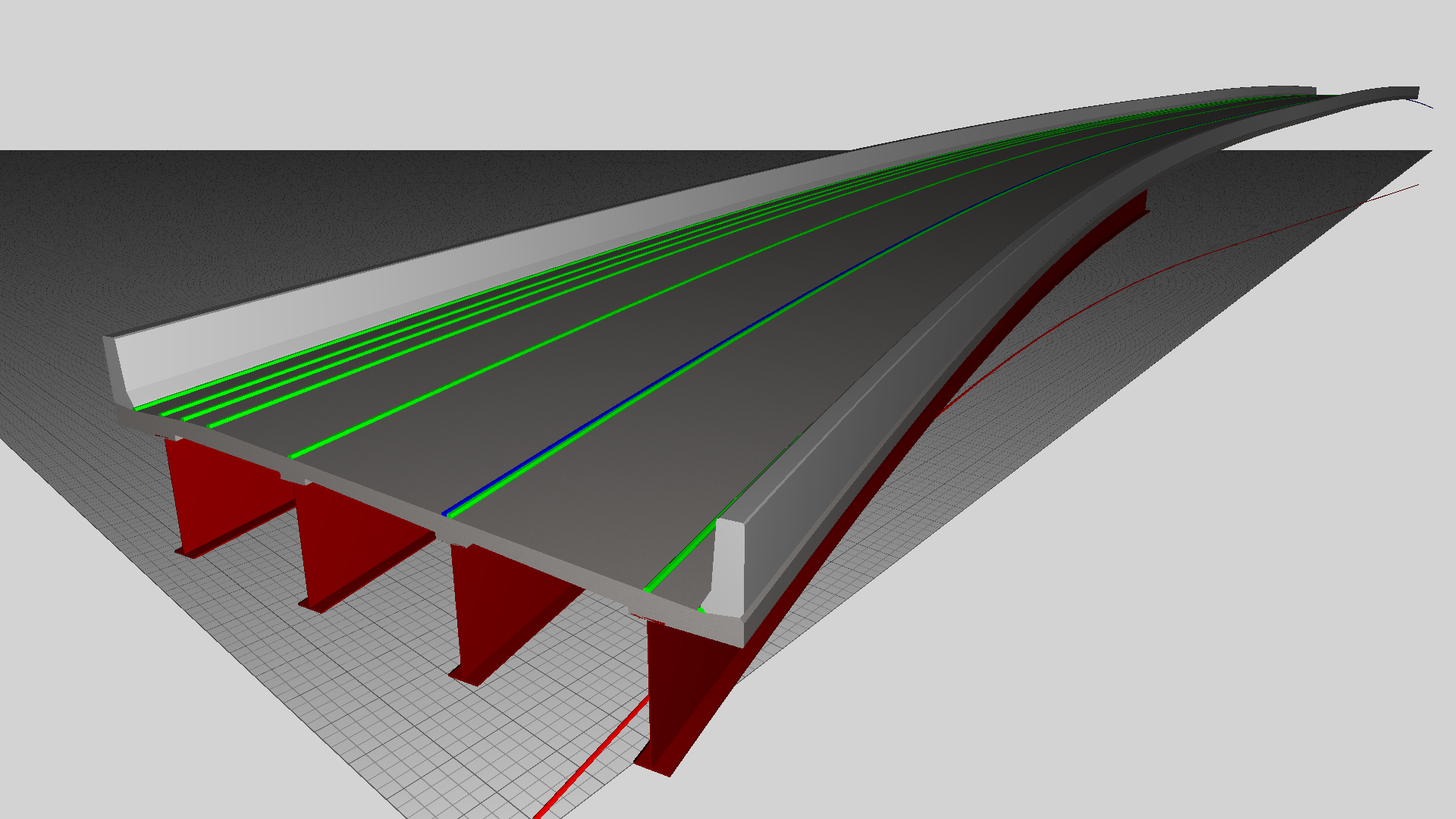Natural language names
 | Sectioned Solid Horizontal |
Change log
| Item | SPF | XML | Change | Description | IFC4x1 Final 4.1.0.0 |
|---|---|---|---|---|
| IfcSectionedSolidHorizontal | ADDED | IFC4x1 Final 4.1.0.0 | ||
| IfcSectionedSolidHorizontal | ADDED |
Semantic definitions at the entity
Entity definition
An IfcSectionedSolidHorizontal is a solid model constructed by sweeping potentially varying cross sections along a curve horizontally.
The solid is generated by sweeping the CrossSections between CrossSectionPositions with linear interpolation of profile points, where the profile normal agrees with the tangent of the Directrix, the profile X axis is oriented perpendicularly to the left of the Directrix (same direction as LateralOffset at IfcDistanceExpression) as facing forward along the directrix, and the profile Y axis is oriented upwards according to FixedAxisVertical.
For sections having cross-section rotated according to a single super-elevation, IfcDerivedProfileDef may be used to indicate such rotation with each ParentProfile referring to the same underlying profile. For sections having cross-section transformed according to multiple super-elevations with points varying independently, each profile may be of a different instance but of same type (e.g. IfcArbitraryClosedProfileDef), and may optionally have cross section points associated to string lines (“guide curves”) using IfcIndexedPolyCurve with IfcCartesianPointList2DLabelled.
Figure 344 illustrates four girders of a bridge having a constant parameterized profile, two guardrails having a constant arbitrary profile (one of them mirrored), and a bridge deck having a variable arbitrary profile.
 |
Figure 344 — Sectioned solid horizontal |
Informal Propositions:
- No two consecutive sections shall intersect.
- If the type of sections is not IfcParameterizedProfileDef (i.e. an arbitrary profile), then the number of points and edges should be the same for two consecutive profiles
- If the directrix is not tangent continuous, the resulting solid is created by a miter at half angle between the two segments.
- Very sharp edges may result in nearly impossible miter; implementer agreements may define acceptable limits for tangent discontinuity or require the directrix to be tangent continuous.
- The directrix shall not intersect
Attribute definitions
| # | Attribute | Type | Cardinality | Description | G |
|---|---|---|---|---|---|
| 3 | CrossSectionPositions | IfcDistanceExpression | L[2:?] | List of distance expressions in sequentially increasing order paired with CrossSections, indicating the position of the corresponding section along the Directrix. | X |
| 4 | FixedAxisVertical | IfcBoolean | Indicates whether Sections are oriented with the Y axis of each profile facing upwards in +Z direction (True), or vertically perpendicular to the Directrix varying according to slope (False). | X |
Formal Propositions
| Rule | Description |
|---|---|
| CorrespondingSectionPositions | The set of cross sections and the set of cross section positions shall be of the same size. |
| NoLongitudinalOffsets | Distance expressions must not use longitudinal offsets. |
Inherited definitions from supertypes
Entity inheritance

Attribute inheritance
| # | Attribute | Type | Cardinality | Description | G |
|---|---|---|---|---|---|
| IfcRepresentationItem | |||||
| LayerAssignment | IfcPresentationLayerAssignment @AssignedItems | S[0:1] | Assignment of the representation item to a single or multiple layer(s). The LayerAssignments can override a LayerAssignments of the IfcRepresentation it is used within the list of Items.
IFC2x3 CHANGE The inverse attribute LayerAssignments has been added. IFC4 CHANGE The inverse attribute LayerAssignment has been restricted to max 1. Upward compatibility for file based exchange is guaranteed. | X | |
| StyledByItem | IfcStyledItem @Item | S[0:1] | Reference to the IfcStyledItem that provides presentation information to the representation, e.g. a curve style, including colour and thickness to a geometric curve.
IFC2x3 CHANGE The inverse attribute StyledByItem has been added. | X | |
| IfcGeometricRepresentationItem | |||||
| IfcSolidModel | |||||
| Dim :=3 | IfcDimensionCount | The space dimensionality of this class, it is always 3. | X | ||
| IfcSectionedSolid | |||||
| 1 | Directrix | IfcCurve | The curve used to define the sweeping operation. | X | |
| 2 | CrossSections | IfcProfileDef | L[2:?] | List of cross sections in sequential order along the Directrix. | X |
| IfcSectionedSolidHorizontal | |||||
| 3 | CrossSectionPositions | IfcDistanceExpression | L[2:?] | List of distance expressions in sequentially increasing order paired with CrossSections, indicating the position of the corresponding section along the Directrix. | X |
| 4 | FixedAxisVertical | IfcBoolean | Indicates whether Sections are oriented with the Y axis of each profile facing upwards in +Z direction (True), or vertically perpendicular to the Directrix varying according to slope (False). | X | |
Formal representations
XML Specification
<xs:element name="IfcSectionedSolidHorizontal" type="ifc:IfcSectionedSolidHorizontal" substitutionGroup="ifc:IfcSectionedSolid" nillable="true"/>
<xs:complexType name="IfcSectionedSolidHorizontal">
<xs:complexContent>
<xs:extension base="ifc:IfcSectionedSolid">
<xs:sequence>
<xs:element name="CrossSectionPositions">
<xs:complexType>
<xs:sequence>
<xs:element ref="ifc:IfcDistanceExpression" minOccurs="2" maxOccurs="unbounded"/>
</xs:sequence>
<xs:attribute ref="ifc:itemType" fixed="ifc:IfcDistanceExpression"/>
<xs:attribute ref="ifc:cType" fixed="list"/>
<xs:attribute ref="ifc:arraySize" use="optional"/>
</xs:complexType>
</xs:element>
</xs:sequence>
<xs:attribute name="FixedAxisVertical" type="ifc:IfcBoolean" use="optional"/>
</xs:extension>
</xs:complexContent>
</xs:complexType>
EXPRESS Specification
ENTITY IfcSectionedSolidHorizontal
SUBTYPE OF (IfcSectionedSolid);
CrossSectionPositions : LIST [2:?] OF IfcDistanceExpression;
FixedAxisVertical : IfcBoolean;
WHERE
CorrespondingSectionPositions : SIZEOF(CrossSections) = SIZEOF(CrossSectionPositions);
NoLongitudinalOffsets : SIZEOF(QUERY(temp <* CrossSectionPositions | EXISTS(temp.OffsetLongitudinal))) = 0;
END_ENTITY;

 EXPRESS-G diagram
EXPRESS-G diagram Link to this page
Link to this page